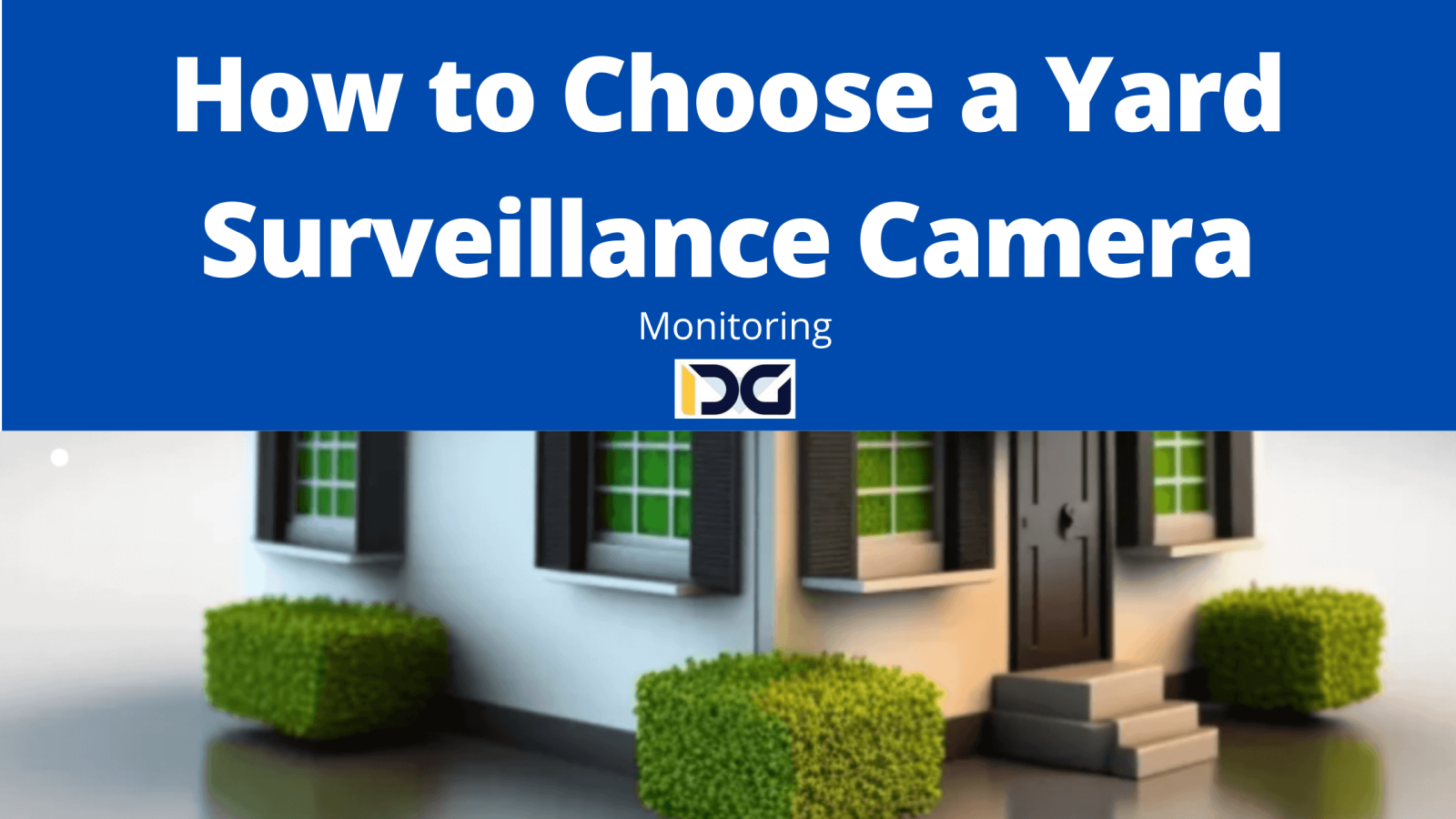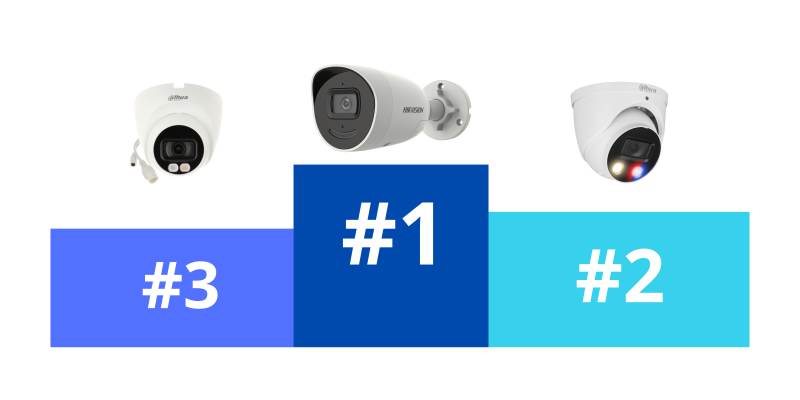
What Camera to Choose for Backyard Surveillance?
An excellent camera for backyard surveillance should be characterized by reliability, durability, and high image quality, including: ✅ Minimum resolution of 2K (2560 x 1440 pixels) or preferably 4K (3840 x 2160 pixels) to ensure detailed recordings.

1. What is the best camera for backyard surveillance?
The HIKVISION DS-2CD2066G2-IU/SL (2.8MM) IP camera is a camera with a resolution of 3200×1800 Px and Dark Fighter technology for high night sensitivity. It features IR illumination and LED for color nighttime imaging. It utilizes AI for distinguishing between people, vehicles, and animals, eliminating false alarms. With a built-in microphone, it supports recording on an SD card up to 256 GB. Its features include face recognition, perimeter protection, heat mapping, crossing virtual lines, and a high IP67 protection rating.
2. What camera should I choose for property monitoring?
The optimal camera for property monitoring should offer 2K or 4K image quality, advanced night vision, a wide viewing angle, and night illumination with smart IR and DEFOG functions, regardless of whether it is wired or wireless.
3. Which cameras are recommended for backyard monitoring?
The list of recommended cameras for backyard monitoring is provided below:
- HIKVISION DS-2CD2066G2-IU/SL (2.8MM)
- Camera IP TIOC 2.0 DAHUA IPC-HDW3549H-AS-PV-0280B-S3
- Camera IP Dahua IPC-HDW2249T-S-IL-0280B
- Camera IP Hikvision DS-2CD2086G2-IU(2.8MM)
- Camera IP KENIK KG-5330DAS-ILC
- Thermal Camera DAHUA TPC-DF1241-D3F4_WS

4.What wireless camera is recommended for backyard monitoring?
When looking for a suitable wireless camera for backyard monitoring, pay attention to the following features: reliability, durability, good video quality, and stable Wi-Fi connection. ✅ It is recommended to choose a resolution of at least 2K (2560 x 1440 pixels) or preferably 4K (3840 x 2160 pixels) for clear images.
What Wi-Fi camera should I choose for backyard monitoring?
IP Camera Orllo Z15 4MPx POE 30x zoom Wi-Fi is an ideal solution for backyard monitoring. With intelligent image analysis and autotracking feature, the camera can automatically detect and track motion, as well as notify you of motion detection. It utilizes Wi-Fi 6 technology, ensuring a stable connection comparable to wired connection. Its high 4Mpx resolution, 360-degree rotation, and 30x zoom provide clear imaging from every angle. Additionally, with technical support and updates, the camera is easy to install and operate.
5. What is the most efficient camera for backyard monitoring?
The most efficient camera for backyard monitoring is the camera HIKVISION DS-2CD2066G2-IU/SL (2.8MM) .
The effectiveness of a backyard monitoring camera depends on various factors such as the size and shape of the backyard, lighting conditions, availability of power and internet connectivity, as well as your individual needs and preferences.
6. Which backyard monitoring camera has the best image quality?
The camera with the best image quality is the HIKVISION DS-2CD2087G2-LU.
The HIKVISION DS-2CD2087G2-LU is a highly efficient camera for backyard monitoring. With its high-quality image sensor, it provides excellent image quality even in low-light conditions.
7. What type of camera is best for backyard monitoring?
The choice of camera type for backyard monitoring depends on specific needs and on-site conditions. Here are several types of cameras that are commonly used for backyard monitoring:
a) Wireless cameras (Wi-Fi): These cameras are easy to install as they do not require cables. However, they rely on a stable Wi-Fi connection, which can be challenging in large outdoor areas. An example of such a camera is the Reolink E1 Zoom-V2 WiFi IP Camera.
b) Wired cameras: Wired cameras are more reliable as they are not susceptible to Wi-Fi connectivity issues. However, they require cable installation, which can be more complex. An example of such a camera is the DAHUA IPC-HDW2249T-S-IL-0280B IP Camera.
c) Cameras with night vision: Cameras with night vision are essential for backyard monitoring, especially if the area is poorly lit. Night vision allows capturing images even in complete darkness.
d) Outdoor cameras: Outdoor cameras are designed to withstand weather conditions such as rain, snow, and extreme temperatures. An example of such a camera is the Orllo Goodcam Z12 Outdoor IP Camera.
e) Motion detection cameras: Motion detection cameras can send notifications or start recording when they detect motion. This can be very useful in a backyard where motion may indicate potential threats.
f) Pan-tilt-zoom cameras: These cameras can rotate to monitor a larger area. They are particularly useful in large backyards where a fixed camera may not cover the entire space. An example of such a camera is the Orllo Z15 POE 30x Zoom Wi-Fi Rotating Outdoor IP Camera.
Remember, regardless of the camera type, it is crucial to ensure that it offers a sufficiently high resolution (at least 2K, but preferably 4K) and has a reliable connection (wireless or wired) that allows for quick and easy access to camera footage.
8. What camera is best for monitoring the backyard at night?
A good camera for nighttime monitoring of the backyard should offer high resolution (Full HD or 4K) for detailed image quality, advanced night vision capabilities, weather resistance, motion detection, appropriate range and field of view, as well as options for wireless or wired connectivity and various data storage methods. Remember that the ultimate choice should depend on individual needs and budget considerations.
9. What are the key features of outdoor surveillance cameras?
The key features that a good outdoor surveillance camera should have are:
-
Remote Monitoring Capability: The camera should have high resolution and range to enable viewing of objects from a distance.
-
Day/Night Functionality: The camera should have a day/night mode to allow monitoring in low-light or nighttime conditions.
-
Wide-Angle Lens: The camera should have a wide-angle lens to provide a broad field of view.
-
Motion Detection: The camera should have motion detection capabilities, preferably with intelligent features, to automatically record and send motion alerts for activity in the monitored area.
-
Integration with Alarm System: The camera should be integrated with an alarm system to enable automatic triggering of alarms upon motion detection.
-
Remote Control: If it is a PTZ (Pan-Tilt-Zoom) camera, it should allow for remote control, enabling users to adjust the viewing angle, zoom, and other settings through a mobile app or web interface.
-
Video Recording and Archiving: The camera should have the capability to record and archive video footage, either through an SD card slot or by integration with an IP or hybrid recorder.
-
Weather Resistance: The camera should be weatherproof and designed to withstand outdoor conditions, ensuring durability and reliable performance.
Remember, the selection of specific features may depend on individual needs, budget, and the specific requirements of the monitored outdoor area.
10. What are the key differences between cameras for outdoor surveillance with daytime and nighttime visibility?
The differences between cameras for outdoor surveillance with daytime and nighttime visibility lie in their specific features designed to cater to different lighting conditions. Cameras with daytime visibility should have high resolution and good image quality for sunny or cloudy days. On the other hand, cameras with nighttime visibility should offer good image quality in darkness through the use of infrared technology or other solutions.
11. What are the key aspects to consider when choosing a camera for outdoor surveillance?
- Lens: It is important to choose a camera with an appropriate lens that allows for the desired field of view and sharpness.
- Resolution: The higher the resolution, the better the image quality will be.
- Night Vision: If you want the camera to capture images in low-light conditions, select a model with good night vision capabilities, such as infrared (IR) illumination.
- Weather Resistance: Ensure that the camera is adequately protected against weather conditions, such as rain or extreme temperatures.
- Remote Control: If you want the ability to remotely control the camera, choose a model with smartphone or tablet control capabilities.
- Additional Features: Some camera models offer extra features like people and vehicle detection, perimeter protection with notifications sent to your phone, and capturing photos and short video clips of events.
12. What are the key requirements for installing and configuring a camera for backyard monitoring?
-
Power Supply Availability: Cameras for backyard monitoring should be powered in a way that makes it difficult to disconnect them from the power source. Possible options include mains power or battery power.
-
Mounting the camera in a hard-to-reach location for unauthorized individuals.
-
Weather Resistance: Cameras for backyard monitoring should be resistant to rain, snow, wind, and other adverse weather conditions. They should have an IP67 weatherproof rating.
-
Internet Connectivity Availability: Cameras for backyard monitoring should be connected to the internet via an Ethernet cable or Wi-Fi to enable remote access through mobile applications or web browsers.
-
Motion Detection Features: Cameras for backyard monitoring should have motion detection functionality to automatically record and send notifications about movement in the backyard.
-
Mobile Application Support: Cameras for backyard monitoring should have a mobile application to enable access through smartphones or tablets.
-
Password Protection: Cameras for backyard monitoring should be password-protected to ensure security against unauthorized access.
13. What are the most important benefits of getting a backyard surveillance camera?
- Security: Cameras for outdoor monitoring allow for maintaining security on the premises by enabling motion tracking and detection of potential threats.
- Control: Cameras enable maintaining control over what is happening on the premises, even when you are not present.
- Documentation: Cameras allow for recording and archiving footage, which allows for reviewing events if necessary.
- Burglary prevention: Cameras can help prevent burglaries by detecting potential intruders on the premises.
- Increased sense of security: Having cameras for outdoor monitoring can enhance the sense of security as they enable monitoring of movement and detection of potential threats.
- Maintaining order: Cameras can assist in maintaining order on the premises by detecting irregularities and taking appropriate actions.
14. What are the key differences between wireless and wired backyard surveillance cameras?
The difference between wireless and wired cameras for outdoor monitoring is that wireless cameras do not require cables to connect to the internet. They are powered from the nearest power outlet, which makes installation much easier. On the other hand, wired cameras are more stable and secure because there is no need to worry about a lack of wireless network connection or interference caused by other devices, which can result in temporary loss of image.
16. What are the main differences between outdoor and indoor backyard surveillance cameras?
The difference between outdoor and indoor surveillance cameras is that outdoor cameras need to be weatherproof, withstanding conditions such as rain, snow, and wind, while indoor cameras do not require such weather resistance.
17. What are the key differences between backyard surveillance cameras with and without motion detection?
The difference between surveillance cameras with motion detection and those without this feature is that cameras with motion detection can automatically respond to motion within their field of view, such as recording video only when motion is detected or sending notifications to a phone upon motion detection in the monitored area. On the other hand, cameras without this feature do not have such capabilities. In modern cameras, these functions are highly advanced, utilizing artificial intelligence to filter out false alarms.
Also check:
Ranking of outdoor surveillance cameras: TOP 8 in 2023
Which monitoring system should you choose for your home? – Guide
